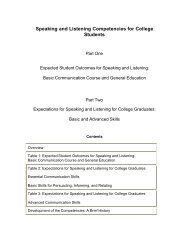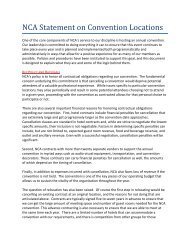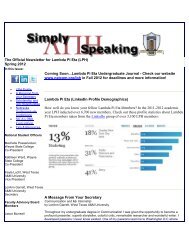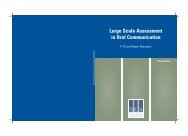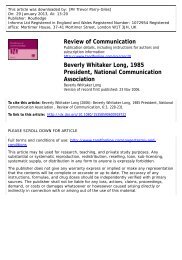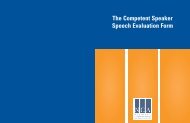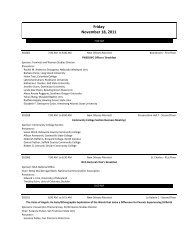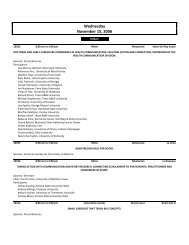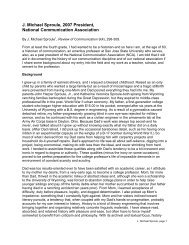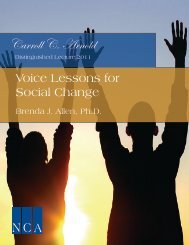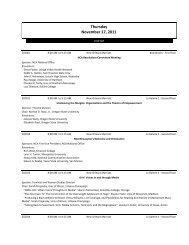Assessing Motivation to Communicate - National Communication ...
Assessing Motivation to Communicate - National Communication ...
Assessing Motivation to Communicate - National Communication ...
- No tags were found...
Create successful ePaper yourself
Turn your PDF publications into a flip-book with our unique Google optimized e-Paper software.
large-lecture/break-out sections) versus self-containedsections. The results indicated that students’ cognitivelearning outcomes were slightly greater in the mixed-sizesections versus self-contained sections. In addition, affectivelearning decreased for all students from the first dayof class, though it decreased slightly more for studentsin the large-lecture/break-out sections. When the teacherwas perceived as highly immediate, however, there wasno difference in affective learning due <strong>to</strong> format.Toale, M. (2001). Ethnocentrism and trait communicationapprehension as predic<strong>to</strong>rs of interethnic communicationapprehension and use of relational maintenancestrategies in interethnic communication.<strong>Communication</strong> Quarterly, 49(1), 70-83.The first of two studies investigated the differences betweenreported relational maintenance strategy usage byhigh and low interethnic communication apprehensives(IECAs). An instrument based on Canary and Stafford’s(1992) relational maintenance strategies taxonomy andNeuliep and McCroskey’s (1997a) Personal Report ofInterethnic <strong>Communication</strong> Apprehension (PRECA)was employed. The results indicated that individuals whowere low IECAs reported utilizing significantly more ofthe task, network, and positivity strategies.Differences in openness and assurance strategies followedthe same pattern but were not significant. Theparticipant’s reported usage and IECA score were inverselyrelated. The second study replicated the firstand explored two theoretical explanations for the results.This study revealed significant differences on allof the dimensions and significant negative correlations.This study also examined whether trait communicationapprehension {disregarding ethnicity) and/or ethnocentrismthe presumed foundational components of IECA)could account for the differences in reports of relationalcommunication behavior. The results of the secondstudy indicated that both trait CA and ethnocentrismcontributed <strong>to</strong> the prediction of IECA and <strong>to</strong> overall reportedstrategy usage, and that ethnocentrism was thebetter predic<strong>to</strong>r.Behnke, R & Sawyer, C. (2002). Reduction in publicspeaking state anxiety during performance as afunction of sensitization processes. <strong>Communication</strong>Quarterly, 50(1), 112-121.Recently, scholars have suggested that biologicalfac<strong>to</strong>rs, such as temperament, influence human socialbehavior, particularly in the formation of traits, such ascommunication apprehension. Despite progress in thisarea, the relationship between temperament and states,such as speech anxiety, remains unclear. Theories oftemperament predict that the rate at which subjectshabituate <strong>to</strong> stress varies inversely with the degree <strong>to</strong>which they are sensitized during initial confrontationwith stress-producing stimuli. The inverse relationshipbetween habituation and sensitization, in the context ofpublic speaking state anxiety, is examined in this report.In two separate studies, using both physiological andpsychological measures of state anxiety, the inverserelationship between sensitization and habituation wasconfirmed. Specifically, sensitization accounted for69.1% and 50.3% of the variance in physiological andpsychological habituation, respectively.Bline, D., Lowe, D., Meixner, W., & Nouri, H. (2003).Measurement data on commonly used scales <strong>to</strong> measureoral communication and writing apprehensions.Journal of Business communication, 40(4), 266-288.Curriculum changes and training advances in businesscommunication have provided students and practitionerswith an opportunity <strong>to</strong> develop and improvecommunication skills. Despite such changes, researchcontinues <strong>to</strong> demonstrate that communication apprehensioncan injuriously impede skills attainment. Yet,the measurement properties of instruments used <strong>to</strong> measureoral and writing apprehension have received limitedattention. In particular, research has not fully exploredthe impact of question order on the measurementproperties of these instruments. This article presents theresults of an investigation about the effect of questionorder randomization on the psychometric properties oftwo frequently used oral and written apprehension instruments.Results showed that the measurement propertiesof these instruments were significantly alteredwhen the question order was randomized.Bodie, G. & Villaume, W. (2003). Aspects of receivinginformation: The relationship between listeningpreferences, communication apprehension,receiver apprehension, and communica<strong>to</strong>r style.International Journal of Listening, 17, 47-57.This study investigated connections between listeningpreferences and patterns of communica<strong>to</strong>r style andapprehension. An initial discriminant analysis was conducted<strong>to</strong> test whether six categories of listening stylesare systematically discriminated by communica<strong>to</strong>r style,communication apprehension, and receiver apprehension.There was one significant discriminant function,whose interpretation was somewhat questionable. Sub-16 <strong>Assessing</strong> <strong>Motivation</strong> <strong>to</strong> <strong>Communicate</strong>




